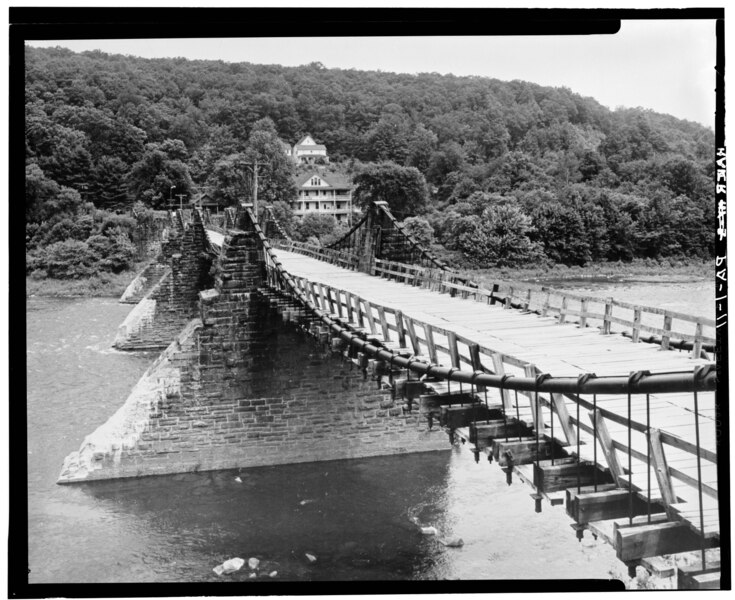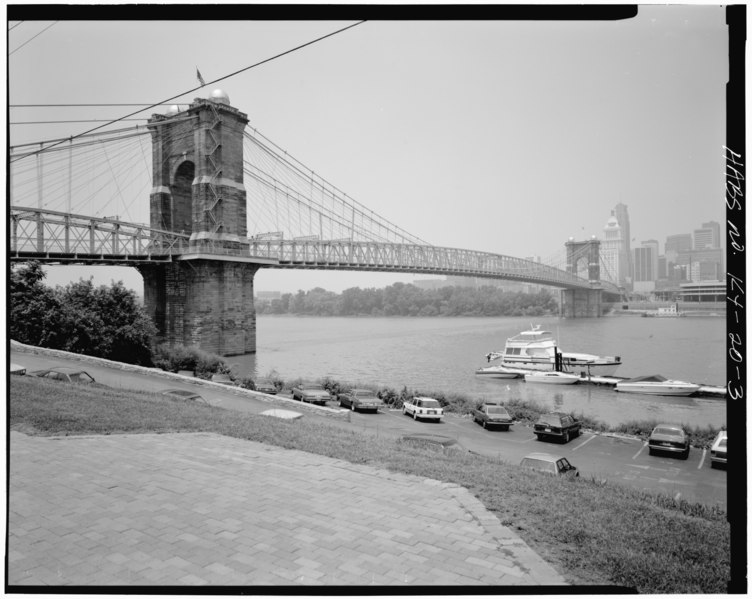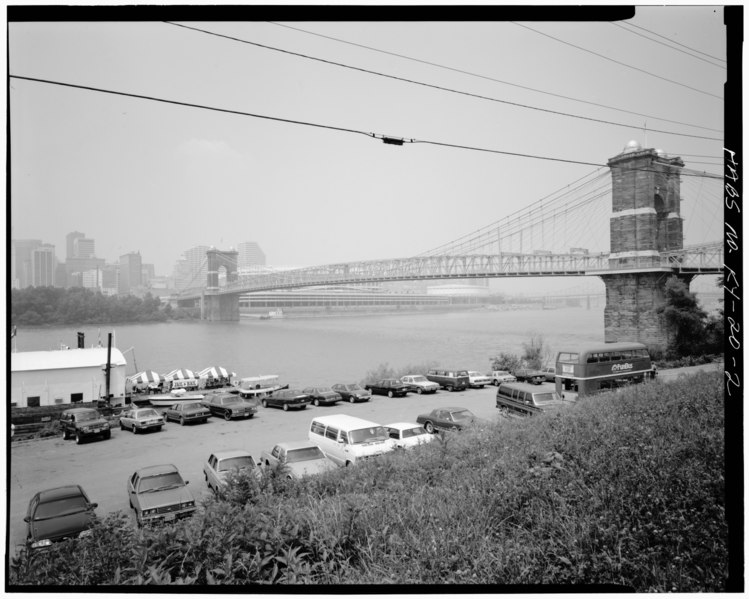Kentucky
The forgotten medical tragedy behind this magnificent Cincinnati-Kentucky bridge
Published
1 week agoon
By
Leo Heit
John Roebling’s Fatal Ferry Accident at Brooklyn Bridge
John Roebling built the massive Cincinnati-Covington Bridge in 1867, then got the job to build the even bigger Brooklyn Bridge. The man who had fought ferry companies for years met a cruel twist of fate on June 28, 1869.
While at the Brooklyn site, a ferry crushed his foot against wooden pilings.
After his toes were cut off, Roebling turned down proper care and poured water over his wound instead. Soon after, tetanus set in.
He died on July 22, 1869, never seeing his greatest work built.
The Covington and Cincinnati Suspension Bridge still stands today as the bridge that made Brooklyn possible.

German Engineer Left Prussia For American Opportunity
John Roebling was born in 1806 in Mühlhausen, Prussia.
He studied engineering at Berlin Polytechnic, where philosopher Hegel talked about America as "a land of hope. " This idea stuck with Roebling.
He moved to the United States in 1831, looking for better engineering jobs. America needed builders, and Roebling needed work.
His first jobs put him on Pennsylvania’s canal system. He noticed how dangerous the hemp ropes were on the canal’s inclined planes.
Workers got hurt when these ropes broke. This problem got Roebling thinking about better options.
Around 1839, he created a technique to make wire rope and got a patent for it in 1842.

Bridge Building Genius Changed American Transportation
Roebling built his first wire cable suspension bridge between 1844 and 1845. This wooden aqueduct carried the Pennsylvania canal across the Allegheny River.
His wire rope business grew in 1848 when he opened shop in Trenton, New Jersey, naming it John A. Roebling’s Sons Company.
He built the Delaware Aqueduct next in 1847-48, which stands today as America’s oldest surviving suspension bridge. Roebling really made his mark with the Niagara River Gorge Bridge in 1855.
This was the first railway suspension bridge strong enough for trains.

Boat Companies Fought Hard Against Roebling’s Bridge Plans
Kentucky approved the Covington-Cincinnati Bridge Company in 1846, with Ohio following in 1849. Ferry operators and steamboat companies didn’t like this plan.
They pushed hard against the bridge, seeing it as a threat to their business.
The Ohio legislature first turned down the bridge charter because ferry companies pulled strings behind the scenes.
These ferry operators made sure the bridge wouldn’t connect with existing roads on either side of the river, even though the street grids lined up perfectly.

Technical Report Blasted Steamboat Owners’ Tricks
Roebling fought back against his rivals with a 36-page technical report in September. He criticized steamboat operators who used big chimneys as an excuse to block bridge building.
His report stressed how important bridges across western rivers were for future trade and travel. Roebling suggested a huge 1,200-foot span with 100-foot clearance that would let steamboats pass underneath easily.
He also argued that the bridge company should pick the location along the river, not politicians who might side with ferry interests.

Construction Started Despite Ferry Company Roadblocks
The project improved when Amos Shinkle joined the bridge company board in 1856. He brought energy and new investors.
Construction began that September with Roebling as both chief engineer and designer. Work on the Covington tower went well at first, with crews putting down 13 layers of oak beams for the foundation.
The Cincinnati side proved much harder.
Water kept flooding the work site, forcing Roebling to create square displacement pumps to keep construction moving forward.

Civil War Put The Bridge On Hold
The Economic Panic of 1857 hurt the project badly. Money ran out, and the company couldn’t pay workers, forcing them to stop construction.
Work started again briefly in 1858, but with fewer workers. They could only build one tower at a time.
Then the Civil War broke out in January 1861, stopping all bridge work completely. Kentucky’s loyalty to the Union hung in the balance, and Confederate threats grew.
Many people thought the bridge would never finish with the country split by war.

War Made The Bridge A Military Necessity
Everything changed in 1862 when Colonel John Morgan led Confederate forces into Kentucky. Suddenly, Covington needed protection.
Union forces built a quick pontoon bridge so troops could cross the river and defend Cincinnati. Military leaders realized they needed a permanent way across the Ohio River.
What started as a business project became a strategic military need overnight.
Investors who held back now put money into the project, seeing both patriotic duty and profit potential.

The Bridge Finally Took Shape After Years Of Delays
Work started again in 1863. Roebling checked the towers and felt glad they stayed strong during the five-year break.
He bought one million pounds of top-quality English wire from Richard Johnson’s factory in Manchester. Workers laid the first wire ropes in September 1865.
The bridge stood complete in December 1866 after years of stops and starts.
It opened on January 1, 1867, as the world’s longest suspension bridge with its main span stretching 1,057 feet across the Ohio River.

Brooklyn Called For Roebling After Cincinnati Success
Roebling’s success in Cincinnati caught attention from New York. In 1867, he got the job as chief engineer for a new bridge across the East River.
His design called for a 1,595-foot span connecting Manhattan and Brooklyn. Just like in Cincinnati, ferryboat operators fought the project hard.
They stood to lose millions if people could walk or drive across instead of taking their boats.
Many citizens doubted such a big bridge could even work, while ferry companies pushed politicians to block construction permits.

Ferry Accident Crushed The Man Who Fought Ferry Companies
On June 28, 1869, Roebling went to check out the Brooklyn Bridge site at Fulton Ferry. In a cruel twist, an approaching ferry crushed his foot against wooden pilings.
Doctors cut off his toes, but Roebling ignored them after the surgery. He refused their medical advice and chose to treat his injury with "water therapy" instead.
This meant pouring water over the wound continuously.
He went through the amputation without any pain medicine and kept using unboiled local well water for his home treatment.

Tetanus From Dirty Water Killed The Bridge Visionary
Three weeks after the accident, Roebling started showing signs of tetanus.
The bacteria had entered his body through his wound, likely from the contaminated water he used for treatment. He died on July 22, 1869, at his son Washington’s home in Brooklyn Heights.
He was 63 years old. His 32-year-old son Washington stepped in as chief engineer right away.
Later, when Washington got sick with caisson disease, his wife Emily Warren Roebling helped finish the job.
The Brooklyn Bridge finally opened in 1883, costing $15 million and claiming 20 more lives beyond John Roebling’s own.

Visiting Covington and Cincinnati Suspension Bridge, Kentucky
You can walk across the Covington-Cincinnati Suspension Bridge for free anytime day or night.
The bridge connects Ohio and Kentucky over the Ohio River with its original 1867 sandstone towers and English wire cables made from 5,180 strands.
Access the Cincinnati side through Smale Riverfront Park and scan QR code plaques for a virtual tour with historical sketches. Visit during RoeblingFest in June for guided tours celebrating the engineer’s legacy.
This article was created with AI assistance and human editing.
Read more from this brand:
Currently residing in Phoenix, Arizona with his wife and Pomeranian, Mochi. Leo is a lover of all things travel related outside and inside the United States. Leo has been to every continent and continues to push to reach his goals of visiting every country someday. Learn more about Leo on Muck Rack.


New Mexico Albuquerque International Balloon Fiesta wrap-ups and fall arts

Mississippi Natchez Trace fall festivals and music events

Minnesota New Ulm and German heritage Oktoberfest events
America’s most liberal places to live in 2025

14 fall camping spots in the U.S. for chilly nights and starry skies

12 Reasons Why You Should Never Ever Move to Florida

Best national parks for a quiet September visit

In 1907, Congress forced Roosevelt to put God back on U.S. coins. Here’s why.

The radioactive secret White Sands kept from New Mexicans for 30 years

America’s most famous railroad photo erased 12,000 Chinese workers from history
Trending Posts

 Pennsylvania3 days ago
Pennsylvania3 days agoHere Are 12 Things People from Pennsylvania Do That Seem Insane To Everyone Else

 North Carolina4 days ago
North Carolina4 days agoHere Are 12 Things People from North Carolina Do That Seem Insane To Everyone Else

 Nebraska6 days ago
Nebraska6 days agoHere Are 12 Things People from Nebraska Do That Seem Insane To Everyone Else

 Maine5 days ago
Maine5 days agoThe ruins of a town that time forgot are resting in this Maine state park

 New York4 days ago
New York4 days agoHere Are 12 Things People from New York Do That Seem Insane To Everyone Else

 South Carolina2 days ago
South Carolina2 days agoHere Are 12 Things People from South Carolina Do That Seem Insane To Everyone Else

 Ohio4 days ago
Ohio4 days agoHere Are 12 Things People from Ohio Do That Seem Insane To Everyone Else

 Minnesota7 days ago
Minnesota7 days agoHere Are 12 Things People from Minnesota Do That Seem Insane To Everyone Else
